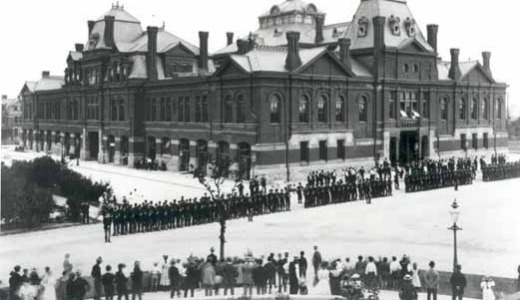
The second half of the 19th century is famous for its robber barons. Names like Carnegie, Morgan, Rockefeller, Stanford, Astor and Vanderbilt are well known even today. While these captains of industry and finance piled up their fortunes, the workers who produced their wealth suffered low wages and bad conditions.
Labor unrest was chronic, but workers were met by repression at every turn. The bosses made no bones about killing strikers to “restore order.” For example, T. A. Scott of Pennsylvania Railroad recommended that workers waging the 1877 Great Railroad Strike should be given “a rifle diet for a few days and see how they like that kind of bread.” Indeed, the Great Railroad Strike was broken by militias and federal troops (around a hundred killed), the 1877 St. Louis general strike was crushed by federal troops and specially deputized police (18 killed), and the 1874 Tompkins Square demonstration was brutally dispersed by over a thousand policemen.
Eugene Debs, speaking on the later Pullman strike, explained the role of the federal troops as the servitors of capital:
“The corporations, left to their own resources of money, mendacity and malice, of thugs and ex-convicts, leeches and lawyers, would have been overwhelmed with defeat and the banners of organized labor would have floated triumphant in the breeze. This the corporations saw and believed – hence the crowning act of infamy in which the federal courts and the federal armies participated, and which culminated in the defeat of labor… The people had long been familiar with such expressions as ‘money talks,’ ‘money rules,’ and they had seen the effects of its power in legislatures and in congress… but it was reserved for them in the progress of the Pullman strike to see this money power, by the fiat of corporations, grasp one by one the departments of the government and compel them to do its bidding as in old plantation days the master commanded the obedience of his chattel slaves.”
Militant working class ideas developed through the struggle. The enemies – capitalists, and their puppets in government; the solution – unity and organization. The social movement began to form unions as its instruments. Militants also formed a number of non-union or pseudo-union labor-oriented organizations. An early example is the Knights of Labor, which peaked at 700,000 members in 1886.
It was in that year that the Knights published their songbook “Labor Songs Dedicated to the Knights of Labor.” In it was Hold the Fort, a revision of a Civil War era religious hymn by the same name. Hold the Fort, with its pro-union and military themes and its emphasis on solidarity, reflected the experience of the embattled working class. Drawing on the collective memory of the great emancipatory struggle of the Civil War, it became the most popular American labor song, which it remained until 1915 when the labor anthem Solidarity Forever supplanted it.
Lyrics
We meet today in freedom’s cause
And raise our voices high.
We’ll join our hands in union strong
To battle or to die.
Chorus:
Hold the fort
For we are coming,
Union men be strong.
Side by side keep pressing onward,
Victory will come.
Look my comrades
See the union banner waving high.
Reinforcements now appearing
Victory is nigh.
Chorus
See our numbers still increasing
Hear the bugles blow.
By our union we shall triumph
Over every foe.
Chorus
Fierce and long, the battle rages
But we do not fear.
Help will come whenever it’s needed
Cheer my comrades cheer.
Chorus
Links
In march style
In ballad style
Another performance
Photo: National Guard vs. railroad workers during Pullman Strike. Via Abraham Lincoln Digitization Project










